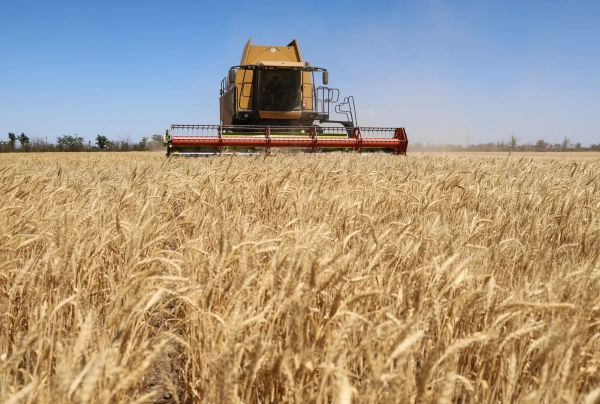“`html 
Should you ever wind up in Battery Park City in Lower Manhattan, make your way down Vesey Street heading for North End Avenue. You’ll come across something remarkable: an assembly of stones, earth, and greenery, thoughtfully arranged to face the Hudson River.
Good News
A regular offering of narratives detailing advancement across the globe.
Email (required)Sign UpBy submitting your email, you agree to our Terms and Privacy Notice. This site is protected by reCAPTCHA and the Google Privacy Policy and Terms of Service apply.
It’s the Irish Hunger Memorial, a work of communal art that remembers the calamitous Irish famine of the 1840s, which brought about the passing of a minimum of 1 million individuals and irrevocably transformed Ireland’s history, compelling the departure of millions more Irish to metropolises like New York.
The Irish famine stands apart for the intensity with which it’s observed, featuring in excess of 100 memorials in Ireland itself and globally. Other famines, notably those that resulted in significantly more fatalities, such as the 1943 Bengal famine in India or the Chinese famine of 1959–’61, generally lack significant communal tributes.
Related
- From Gaza to Sudan, conflict is fueling an increase in global starvation
This ought not to be the case. Analysts approximate that, from 1870 onward, approximately 140 million individuals have succumbed to famine. When tracing back further in time, famines become increasingly widespread and lethal. A particularly dreadful famine in northern Europe in the early 14th century resulted in the loss of approximately 12 percent of the region’s total population within only a few years. Even during times without famine, the accessibility of sustenance exerted a perpetual strain on the human populace.
Related
- How Trump is making America hungrier
Therefore, even though hunger remains excessively prevalent today, famines are significantly less frequent — and predominantly arise as a consequence of human mistakes instead of crop failures. This signifies one of the foremost accomplishments of humankind in the contemporary era, an achievement we often neglect to acknowledge.
A bumper harvest
The outlook becomes even more encouraging: based on current evaluations, the world is positioned to cultivate a greater volume of grain this year than previously. The UN’s Food and Agriculture Organization (FAO) anticipates unparalleled output levels for worldwide grain crops, including wheat, corn, and rice, throughout the 2025–’26 agricultural period. Concealed within this information lies another equally vital statistic: a global stocks-to-use proportion of approximately 30.6 percent — signifying that global manufacturing of these essential crops surpasses current demand by nearly a third.
The US Department of Agriculture’s August forecast supports this trend: an all-time high US corn crop, and more vitally, an unprecedented yield, or the quantity of crop generated per land area. The yield statistic is particularly crucial: amplified yield per land unit reduces the required cultivation area to fulfill global food demands. The FAO Food Price Index, monitoring the expense of a worldwide assortment of dietary commodities, has marginally risen this year, but is still almost 20 percent below its apex during the initial stages of the conflict in Ukraine.
Taking a broader perspective, the degree of advancement becomes clearer. Average available calories per individual worldwide have been consistently increasing for decades, moving from approximately 2,100 to 2,200 kcal/day during the early 1960s to just under 3,000 kcal/day by 2022. Concurrently, grain yields have essentially increased threefold since 1961. These concurrent trends — increased food availability per person and augmented grain yield per hectare — have facilitated our escape from the enduring Malthusian constraint.
A green revolution
So, what developments led to this?
Similar to cultivation, begin with the seed. The short-straw wheat and rice varieties introduced by the Green Revolution maximized fertilizer efficiency, hybrid seed varieties enhanced yields, genetically altered crops appeared in the ’90s, and CRISPR technology now enables breeders to execute precise modifications to a plant’s inherent genes.
Subsequent to acquiring the seeds, fertilizer becomes crucial. Once reliant on natural nitrogen sources that incited a hurried collection of nitrogen-dense dried avian excrement or guano during the 19th century, the world witnessed the 1912 development by Fritz Haber and Carl Bosch of a method to generate synthetic nitrogen for use as fertilizer. The Haber-Bosch process holds such significance that it likely underpins half of present-day food production.
Incorporate water. Whereas most farmers previously relied on weather patterns to irrigate their crops, irrigated farmland has more than doubled since 1961, now delivering nearly 60 percent of global grain yields and, subsequently, half the world’s caloric intake. Highly productive agricultural regions, such as California’s Central Valley, would be unthinkable without intensive irrigation systems.
Finally, ensure food distribution. Enhanced logistical frameworks and global commerce have forged a network capable of rerouting calories from areas of surplus to those experiencing deficiencies during localized crises.
However, this is not to say the existing system operates faultlessly — or eternally.
Why do we still have hunger?
Although global crop production routinely surpasses adequate caloric levels, billions continue to lack access to healthy diets. The World Bank estimates roughly 2.6 billion individuals cannot afford a nutritious diet. While this figure has marginally decreased in comparison to previous years, the situation is deteriorating in sub-Saharan Africa.
In contemporary instances of famine, the origins tend to be more politically motivated than rooted in agronomy. The devastating famines in Gaza and Sudan, with over 25 million individuals threatened by starvation, underscore the repercussions of human-caused access failures in a world of sufficient resources. (However, particularly in Gaza, the indicated peace agreement offers renewed optimism for alleviation.)
An additional obstacle to the fight against famine is climate change, which also has a political aspect. While basic crop harvests and yields have thus far exhibited resilience against the impacts of global warming, climate scientists caution that increasing temperatures pose escalating risks to food stability, notably via heatwaves, droughts, and overlapping calamities capable of simultaneously impacting multiple vital agricultural areas. Encouragingly, adaptation tactics — improved agronomy, stress-resistant crop types, irrigation optimization — can mitigate losses up to approximately 2 degrees Celsius. However, options could become more limited beyond that threshold.
A more self-inflicted injury could arise from trade limitations. One of the most severe recent food price escalations, occurring in 2007 and 2008, stemmed less from production deficits than from political decisions, as governments enforced export restrictions, precipitating price surges that disproportionately impacted impoverished populations. This creates a concerning precedent, particularly given the Trump administration’s intensified advocacy for tariffs and trade impediments.
The Irish Hunger Memorial serves as a stark reminder of the potential destructiveness of scarcity — and the extent of our progress. Following millennia when hunger was a constant presence, humanity has established a food infrastructure that, despite its imperfections, sustains eight billion people and continually establishes harvest benchmarks. Despite the trials confronting us today and those anticipated in the future, this narrative warrants recognition.
An early form of this piece first ran in the Good News bulletin. Subscribe here!
“`
Source: vox.com






